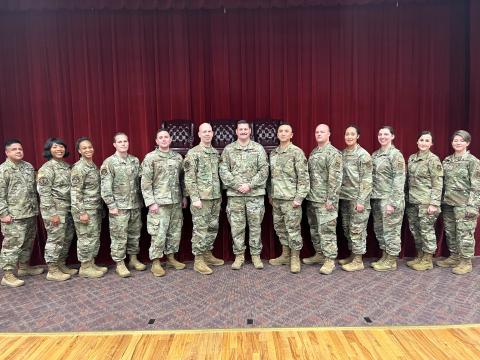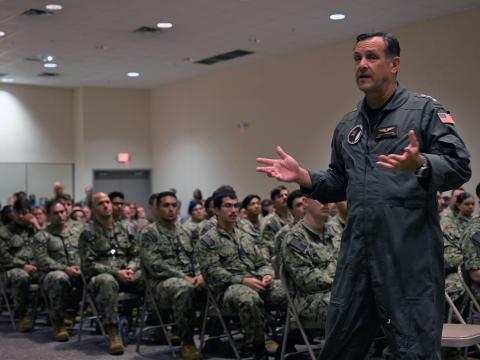Army Transforms Information Systems Management Paradigm
Networks to be managed at enterprise level.
The command in charge of the U.S. Army’s information systems is refocusing the way it provides services to its 1.3 million users. For the first time, Army personnel will receive a negotiated level of support that is based on service-level objectives and performance indicators. This effort, information managers say, will lead to measurable improvements in the quality of information processes the Army uses in its missions. In addition, this new service-level management process is scalable to the entire Army, they warrant.
The new paradigm is key to the service’s transformation imperative: operate and manage the Army’s networks at the enterprise level. This decision sets in motion a number of initiatives that change the way the Army manages, stores, transmits and uses information and makes the information infostructure leaner, more secure and more responsive to customers and Army missions.
The activity begins at the chief information officer/G-6 (CIO/G-6) level, and the service’s chief information officer has organized the information management community for battle. The U.S. Army Network Enterprise Technology Command/9th Army Signal Command (NETCOM/9th ASC), Fort Huachuca, Arizona, is administering the new service-level management (SLM) program. As the enterprise manager, NETCOM/9th ASC will embed the most effective business practices into its information management program.
According to Col. Mark Barnette, USA, chief, information infrastructure modernization branch, CIO/G-6, adopting this measured service-based performance approach as a core enterprise philosophy is the underpinning for the way the Army will deliver services to Army information technology users around the world. “The development of performance-based delivery of command, control, communications and computer information management [C4IM] services moves us closer to industry standards, best practice processes and commercial solutions,” he says. “Our leadership in the area of information technologies and our commercial standards and practices are revolutionizing the way private industry is doing business. Our strategic joint as well as Objective Force imperatives for moving toward a network-centric environment drive us to leverage these private sector achievements and adopt and adapt for their use in the Army.
“Additionally, service-level management provides global, assured and homogeneous access to heterogeneous information from all sources and allows for rapid exploitation … by individual and organizational users, which can be customized to meet specific mission demands,” Col. Barnette says.
One key to the overall success of transformation is the development of a new service management program. This program is designed to put the customers in the driver’s seat by focusing on their requirements, while developing service standards that are measurable and negotiable.
In addition to changes in service focus, other actions are taking place throughout the Army that will have a real effect on how the fledgling service management program will be managed. Chief among them is the establishment of the Installation Management Agency (IMA), with its mandate to bring centralized control to the Army’s scattered posts, camps and stations. The IMA organized the Army installations into seven distinct geographical regions and included functional activities like the Army Corps of Engineers in the structuring. It then assigned a director who looks to a regional chief information officer (RCIO) for advice and guidance on C4IM service. NETCOM/9th ASC, the RCIO and the directorates of information management (DOIMs) form the organizational triad for SLM, with NETCOM/9th ASC providing technical control over DOIMs as they deliver service.
Erik Peterson, who brings years of C4IM service delivery experience to his current position as the service-level agreement chief for the Southeast RCIO, explains the current thinking on service management by comparing two kinds of team leaders and the services and support climate they must develop. “How can competition be employed to enhance performance where a profit motive does not exist? How can the DOIMs, who service customers on Army installations, be energized with a competitive spirit? The answer comes by looking at the Yankee sea captains rather than the New York Yankees. Baseball teams win by merely defeating the opposing team, regardless of their level of performance. The sea captain, in contrast, had to provide a regular service that met or exceeded the expectations of the merchants he served. That is the essence of service-level management,” Peterson says.
The Enterprise Systems Technology Activity (ESTA), located at the command, is providing direct support to this effort. An important component of the activity is its service management division, which is leading the charge across uncharted territory. This small team seeks to move C4IM service from its decades-old reliance on a systems-focused approach to its new, revolutionary customer-centric, service-focused way of doing business.
Brian Crawford, team leader, describes the ESTA’s approach as a kind of Skunk Works for C4IM service delivery and performance. Based on the Lockheed Martin design group, a Skunk Works is a group of people who, in an effort to achieve unusual results, work on a project in a way that is outside the usual rules. It is often a small team that assumes or is given responsibility for developing a solution or approach in a short time with minimal management constraints and sometimes spearheads a product design that thereafter will be developed according to the standard process. “First, we do the kind of in depth research it takes to establish a factual basis for what we are trying to do. Then, we do the field testing and adjust our thinking,” he explains.
For Crawford’s team, the process began almost a year ago when NETCOM/9th ASC officially opened for business and accepted the task of managing the Army enterprise. Right from the start, Crawford and others believed that the new enterprise needed a different way of gauging service success. As a result, the current SLM program was born.
Crawford put together a team of service visionaries who turned to work done by such private and public sector SLM pioneers as Rick Sturm, president of Enterprise Management Associates, and the independent Information Technology Infrastructure Library (ITIL). Sturm, a long-time advocate of SLM, has written extensively on the subject, while the ITIL has provided public sector organizations such as the United Kingdom’s Department of Commerce with significant service delivery improvements.
“We wanted to make sure that what we did for the Army had the right foundation, based on best industry practices. We recognized that what we were building in the service-level management area had never been attempted on such a large scale in an organization as large and as diverse as the U.S. Army, and we wanted to get it as close to right as possible,” Crawford says.
Thomas Berezny, one of the members of Crawford’s team, explains the tremendous changes taking place in the C4IM services arena. “There are a number of paradigm shifts taking place right now. First, organizations will no longer be distracted from their mission by providing C4IM services to users in the organization. That will be taken care of by the service provider community on Army installations, for example, DOIMs and the signal battalions overseas,” Berezny says. “Customers—tenants on an installation/garrison—will see the services and will no longer have to manage the technology that provides those services.”
Berezny adds that the second paradigm shift involves the reach for standardization in the way the enterprise is operated, managed and defended. According to the recently developed Army C4IM Service Management Program, all DOIMs will be able to use the same methodology when applying SLM principles. This standardization will be reached across the enterprise by using the ITIL framework for service management and network operations.
“The third paradigm shift is that the customers of reimbursable services will actually be able to receive performance-based data on services. This will let the customer know just how well the service provider community is doing,” he offers.
What excites the service management division team the most is the move to a performance-based service approach for the enterprise that will also implement the current system capability approach. When the Army can merge the performance-based information from SLM with the capabilities-based metrics in the information technology metrics program and in installation status reports, it becomes more efficient and effective.
This efficiency is further enhanced by the development of a standardized C4IM services list that clearly spells out which services all DOIMs currently provide across the Army as the Army moves toward full enterprise implementation. Later, as the program moves forward, a services catalog will capture the essence of this list and include costs and other features not currently found on the list.
The last foundational effort underway is the development of templates for service-level agreements. These contracts between a direct-service provider and customer are the result of reviews of existing service contracts and the development of operational-level agreements. These underpinning processes are designed to help direct-service providers ensure that C4IM services will be delivered at the agreed-upon levels.
The significant point, according to Col. Barnette, is that the new SLM process will change the way the Army manages services. “Service management allows us to measure performance and determine costs. More importantly, for warfighting purposes, it provides a common language for information technology service provisioning. A customer should not have to care how the service is provided. For example, the customer should need only to request nonsecure Internet protocol router network service and let the C4IM services staff figure out the appropriate means. … This is a move toward linking performance to capabilities,” Col. Barnette says.
Crawford adds that SLM is not a mystical shortcut. “It requires the concerted efforts of both information management personnel and our customers. SLM’s primary benefit is that it focuses our efforts on what we should be doing as information technology managers: supporting our customers.”
James H. Ward is a service-level agreements action officer for the Service Level Management Directorate, Enterprise Systems Technology Activity, U.S. Army Network Enterprise Technology Command/9th Army Signal Command, Fort Huachuca, Arizona.



